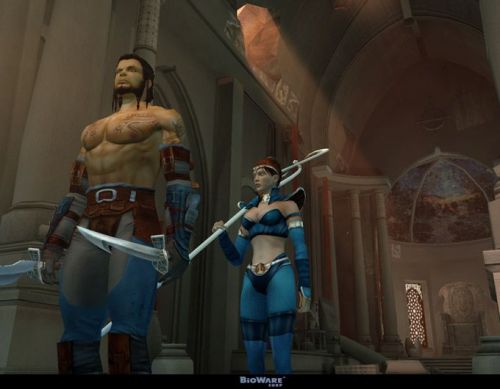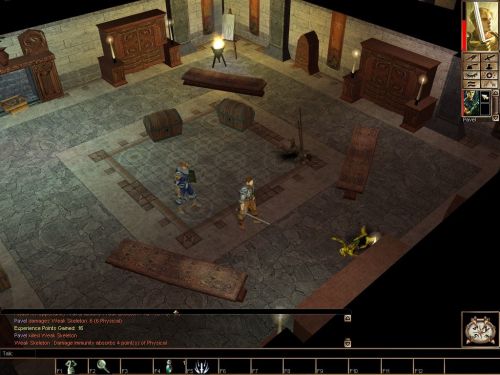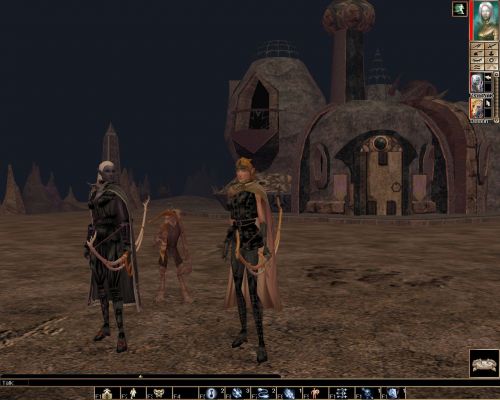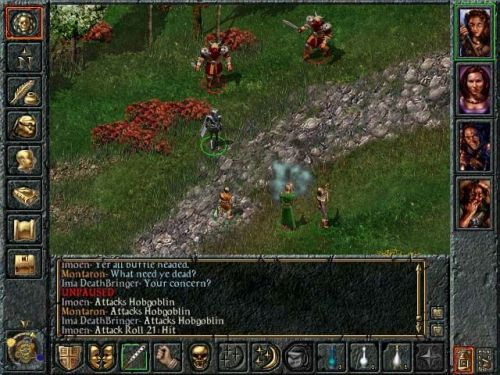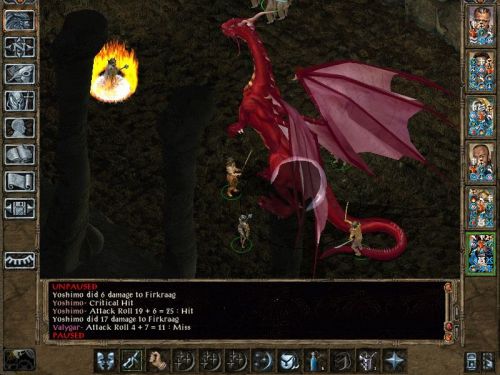Brent Knowles Interview: An Insider's Look at BioWare, 2000-2009
Brent Knowles Interview: An Insider's Look at BioWare, 2000-2009
Codex Interview - posted by Infinitron on Wed 21 January 2015, 00:31:22
Tags: Baldur's Gate II: Shadows of Amn; BioWare; Brent Knowles; Dragon Age: Origins; Neverwinter Nights; Neverwinter Nights: Hordes of the Underdark; Neverwinter Nights: Shadows of UndrentideIn the year 2000, BioWare released Baldur's Gate II: Shadows of Amn, one of the most acclaimed computer RPGs of all time. In 2009, they released Dragon Age: Origins, a game that was purportedly similar, but very much a product of its time. It was the product of a company which over the course of that decade, had gone from being a small developer of PC-exclusive D&D RPGs to a cinematic console RPG powerhouse, with titles such as Knights of the Old Republic, Jade Empire and Mass Effect. And between them was Neverwinter Nights, controversial and misunderstood black sheep of the family, along with its expansion packs, Shadows of Undrentide and Hordes of the Underdark.
The truth is that you could probably write a book about what happened to BioWare during the first decade of the new millenium. Since DarkUnderlord doesn't pay us enough to write books, we'll have to make due with interviews, which can give us a glimpse at what was going at the company during that time. And what better individual to interview than Brent Knowles, the man whose career at BioWare spanned that exact duration? Starting off as a junior designer on Baldur's Gate 2 in late 1999, Brent eventually rose to become one of the lead designers on NWN, sole lead on its expansion packs, and most famously, lead designer on the Dragon Age franchise, until he was replaced by one Mike Laidlaw after leaving the company in 2009.
You might remember that Brent was briefly famous during the Dragon Age II brouhaha, when his personal blog posts describing the end of his tenure at BioWare, which confirmed fans' worst fears about the direction the franchise was heading, were brought to public knowledge. With the recent release of Dragon Age: Inquisition, we felt it was a particularly appropriate time to revisit Brent and ask him a few questions about his time at BioWare. To be honest, it was actually way more than "a few", but Brent graciously replied to them all anyway. Read on, then, for...

An interview with Brent Knowles
Read the full article: Brent Knowles Interview: An Insider's Look at BioWare, 2000-2009
The truth is that you could probably write a book about what happened to BioWare during the first decade of the new millenium. Since DarkUnderlord doesn't pay us enough to write books, we'll have to make due with interviews, which can give us a glimpse at what was going at the company during that time. And what better individual to interview than Brent Knowles, the man whose career at BioWare spanned that exact duration? Starting off as a junior designer on Baldur's Gate 2 in late 1999, Brent eventually rose to become one of the lead designers on NWN, sole lead on its expansion packs, and most famously, lead designer on the Dragon Age franchise, until he was replaced by one Mike Laidlaw after leaving the company in 2009.
You might remember that Brent was briefly famous during the Dragon Age II brouhaha, when his personal blog posts describing the end of his tenure at BioWare, which confirmed fans' worst fears about the direction the franchise was heading, were brought to public knowledge. With the recent release of Dragon Age: Inquisition, we felt it was a particularly appropriate time to revisit Brent and ask him a few questions about his time at BioWare. To be honest, it was actually way more than "a few", but Brent graciously replied to them all anyway. Read on, then, for...

An interview with Brent Knowles
Read the full article: Brent Knowles Interview: An Insider's Look at BioWare, 2000-2009

An interview with Brent Knowles
To start things off, can you tell us a bit about how BioWare was organized as a company from 2000 to 2009? It's always seemed to me like you had a "console wing", comprised of the folks who developed Knights of the Old Republic and later Mass Effect, and some kind of "old guard PC wing", comprised of the folks who developed and maintained Neverwinter Nights and later Dragon Age: Origins. Is that in any way an accurate reading?
I suppose the idea that there was a console wing and a pc wing is partly true. The way the various teams came together though, wasn't quite so intentional. Different groups just ended up working with various technologies -- there were lots of PC guys in the "console wing" who happened to end up there (and vice versa). And there was always a fair bit of movement between the groups, when it was required. Certainly it wasn't a rigid separation, or even a divisive separation.
Between 2000 and 2009 the department structure at BioWare had a leveling influence, regardless of the platforms/engines being used. Within the design department, for example, we would have regular reviews of each other's work-in-progress. So there was a lot of communication between the groups.
Between 2003 and 2007, BioWare had only a single, fairly minor, release - Jade Empire. In this age of publisher hysteria over annualization of franchises, with independent developers struggling to survive, it's frankly a bit hard to believe! What exactly was going on at BioWare during that period and how did you manage to survive?
I was too damn busy working to worry much about finances. I credit Ray and Greg and the other senior staff with keeping BioWare going through droughts. They put in crazy hours and worked wonders with investors (I suspect KOTOR's success helped with this). And I suppose revenue was coming in from royalties on past projects as well as the expansion packs.
BioWare's console guys managed to release a good number of games during the 2000s - KOTOR, Jade Empire, Mass Effect. Meanwhile, Dragon Age took a staggering 6+ years to finish. Why did it take so long? Was it really in full production for that entire time?
This is a complicated story. Obviously DA was not in "full production" the entire time. In the first few years, many DA team members were actually helping on other projects (i.e., I was gone for about half a year on Jade Empire to help that project finish). Others, like James, always had a fair bit of involvement with other projects.
That said, it was a large team, for a very long time.
Essentially there was a combination of technology and "people" changes over time that delayed things. The technology changes often forced adjustments to existing assets (art and design)... which created new delays. There were also team shake-ups over the years, with employees coming and going, and this created delays as the new team members were brought up to speed. (And of course newcomers like to inject their own ideas into a project… creating further delays.)
Most projects that run into 3+ years of development face these challenges. Basically, delays birth further delays, and it can become a negative cycle. The effect on Dragon Age was exacerbated, I think, because it had an incredible number of assets. A major change or impact event to even a handful of those assets created repercussions across a vast swath of other assets.
Games with such a long development cycle usually turn out to have gone through several different iterations, often with very different concepts behind them. Can you give us an overview of Dragon Age's previous incarnations? How different was the end product from what you initially had in mind back in 2004?
I think the high level design behind Dragon Age matches up fairly well with early plans (though this is almost ten years ago and my memory of it may not be entirely accurate). A big change I do remember was a move from a High Fantasy setting to a more realistic world. I do not remember when that happened exactly but that was a fairly significant shift. But it happened pretty early on.
Another change was with regards to the rules. We spent a lot of time working with a simulator (and pen-and-paper play) to balance the original rule set, but once the final engine was ready, much of that balancing was invalidated as the rules underwent significant changes to accommodate animation and art requirements that I failed to foresee.
The art and the minutia of how the game played also changed quite a bit (re: the delays I previously mentioned), but the actual concept of selecting Origins and having those be a lens through which the player views the rest of the game, stayed fairly the same.
We built the game originally in the Neverwinter Nights engine, so we were able to play through story quite early on and iterate on individual plots -- obviously without real assets or cinematics. It was harder to get a feel for the full narrative in these prototype builds (i.e., the over-arching plot connections) but it helped us develop a feel for how the individual origin stories would work, and allowed us to evaluate each plot, well before the final engine was ready.
Obviously once we ported the content into the new engine we ran into new difficulties, but I don't remember any of those hurdles necessitating major changes, directly.
Was Dragon Age's long development time a factor in the change in direction the series was forced to undergo? Like, did somebody decide that "Dragon Age: Origins-type RPGs just take too long to develop, so we can't make them anymore"?
I don't know. Obviously nobody liked how long it took for Dragon Age to be completed, but I think it was more a case of Mass Effect succeeding really well.
Though a smaller game from a content point of view, Mass Effect still felt like a big game (for many players, at least). The player voice and cinematic treatment made it extremely attractive. It became more difficult over the years to argue for doing anything markedly different from what Mass Effect was doing. It was a project that struck much closer to its schedule, did very well (ratings and sales) and had the wow factor (the Silent Protagonist of DA: Origins never had the appeal that Shepard did, whether in company meetings, publisher proposals, or on press tours).
Basically, a voiced protagonist, and the cinematic elements required to pull that presentation off properly, makes it extremely risky to attempt an asset heavy game like Dragon Age: Origins.
Can you tell us about any interesting content that had to be cut from Dragon Age? Stuff you wish you hadn't been forced to cut? Were there things cut because they were too "hardcore" or difficult?
I don't actually remember much, which is funny because I recall being outraged at particular cuts. But I forget what those were! This happens a lot with game development -- you'll fight for weeks or months for a particular plot or characters and yet, a couple years after the game is released, you don't even remember it.
I do recall a couple of promising Origin stories that were axed. Effectively the origin stories that had unique art requirements, or other unusual feature-requests, were always at risk. Whenever we had to make up "design time" in the schedule, these became targets, and several were lost over the course of development.
(I actually kind-of remember content that was cut from Neverwinter Nights however. There was a different ending sequence that I remember scripting (I think Drew wrote it). Don't know if anybody talked about it or not, but I'm sure it is still sitting on a network drive somewhere at BioWare. I vaguely recall a dream sequence and a looping time-travel puzzle of sorts.)
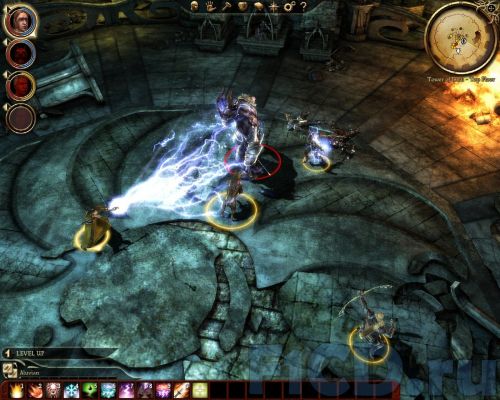
Dragon Age: Origins - next-gen mediocrity, or last of a dying breed? Probably a little bit of both.
Dragon Age was marketed as a "spiritual successor to the Baldur's Gate series", but to a lot fans of Baldur's Gate, that was pretty far from the truth. With its smaller party, 3D graphics and MMO-ish cooldown mechanics, they didn't think it was much like Baldur's Gate at all. But it does raise the question - was the game ever more similar to Baldur's Gate than it ended up being? Or was it always just going to be similar to Baldur's Gate only in the broadest sense (party-based, top-down perspective, etc)?
I think some of this is quibbling over terminology. It was always going to be a "spiritual successor" versus an actual successor. It was never going to be Baldur's Gate 3.
Party-based, top-down, large selection of abilities, reasonable selection of party members and… a Silent Protagonist. We focused on the elements we felt best described the overall experience of the Baldur Gate games.
We know that Dragon Age was originally going to be a PC-exclusive, at least on launch. What had to be changed when it became multiplatform? For example, were there ever any plans to have a traditional grid-based inventory, rather than a console-style list-based one?
My memory of this is foggy but I think we talked about a grid-based inventory and may have even played around with it, but I'm fairly sure it was a list-style inventory for much of the project.
Much of the streamlining (in interface/ability progression, et cetera) that happened was not done to accommodate consoles. Early on we had some team members in high positions who wanted things simplified and others who wanted it more complicated. There was much discussion, across all features, on how to accommodate wider audiences while remaining true to the BG2 spirit. Compromises were made, right from the very beginning of development.
So, specifically, I don't think the inventory system changed to accommodate console, I think it was the other way around. A whole lot of the game mechanics and interface mechanics ended up working okay for console interfaces and therefore it was decided that it was not going to be a prohibitively expensive port.
BioWare became a property of Electronic Arts in late 2007. How exactly did that influence the development of Dragon Age? Was there pressure from above to change things? We know that there was a definite shift in the way the game was marketed, including a change of logo that many fans came to see as ominous in retrospect. But what of the game itself?
In my opinion, Electronic Arts had no real influence on Dragon Age: Origins. At that point there had already been so many delays that nobody sane would have considered adding any more hurdles to the project. Yes, there were perhaps some misdirected marketing messages, but the game itself… there's nothing that changed that I can remember that was prompted by Electronic Arts.
To a lot of fans, it feels like EA was horrified by what Dragon Age was. Like, "Oh my god, what is this relic? You guys never said anything about a tactical party-based RPG! I thought we were buying Mass Effect! How do we sell this?" Puzzlingly, it seems like that attitude persisted even after the game proceeded to sell fairly well on release. They didn't seem proud of it - instead, it was like they were downplaying it, like they were ashamed of it. Is there any truth to that perception?
I don't really know. I wasn't with the company by the time Dragon Age was released. I know marketing groups have always had problems with tactical party-based RPGs. They are not as sexy as first person shooters, for example, and it takes a skilled marketing team to brand and sell games like these.
Neverwinter Nights was a controversial game. Back in 2002, a lot of Baldur's Gate fans were fully expecting a game that delivered more-or-less the same kind of experience that the Infinity Engine games did. Instead, they received something that was in many ways the complete opposite. Gone was the lovely 2D, replaced with repetitive tiled 3D graphics. Gone was the player-controlled six man party, replaced by simplistic autonomous "henchmen". Gone was the tactical combat, the difficulty, the thoughtful encounter design, replaced by hordes of "trash mobs" who dotted the maps of the game's lackluster original campaign. It would not be an exaggeration to say that for many fans, the day they loaded up NWN for the first time was the day that the "old BioWare" died in their eyes.
Personally, I found some enjoyment in NWN's original campaign as a kind of "3rd Edition D&D character build simulator", but I have to ask - just what the heck was going on there? Surely you guys were aware of what sort of product you were creating and how people would react to it? There's actually been a debate about this among RPG fans over the years. Was NWN's original campaign meant to be the way it was - basically just a low-effort tech demo for the game's toolset? Or was it originally meant to be something more, perhaps more similar to the Infinity Engine games?
These design documents that were leaked to the NWVault in 2008 suggest the latter. Could you tell us anything about them? The storyline described in these documents is a lot more detailed and complex than what we got in the final product. Was there ever any chance of it being implemented?
In the Neverwinter Nights wiki entry on the cut storyline, it says that Rob Bartel claimed that NWN's change of scope happened due to the change of publisher from Interplay to Atari. Could you tell us more about the transition from Interplay to Atari, and what effect it had on the game, and on BioWare?
Yes, a more elaborate campaign was intended for Neverwinter Nights.
Neverwinter Nights was an ambitious project. From a technological point of view, it was, and still is, an incredible engine for designers to play with. Certainly the most fun I've ever had, in regards to the mechanics of building a game. But it took a very long time to be useable, or for the team to understand even how to use it properly.
The transition from Interplay to Atari also introduced problems. I believe some of the characters and situations that were part of the original campaign, we no longer had the rights to. Given our other time constraints, the retooling of the main campaign to deal with the legal repercussions of the publisher change, led to more draconian changes, than might otherwise have been required. (i.e., if you find that you have to cut pieces out of something, sometimes it is easier to just start from scratch).
Other than that I don't know much more (regarding the legal situation specifically). I was fairly junior at the time and all I really remember of this was spending a lot of time printing documents to give to management to send to lawyers.
There were other difficulties though with simply creating a Baldur's Gate experience with Neverwinter Nights… and that was multiplayer. The Baldur's Gate multiplayer experience was adequate but wouldn't work for what was intended for Neverwinter Nights. The "guidelines" that technical folk like myself developed for creating a fun multiplayer experience ended up forcing constraints on how the story could be designed.
This was problematic, obviously. These guidelines put limits on how items and plot variables functioned, which constrained how the writers wrote the story and how technical design put everything together. Could we have done more with it than we did… certainly… but we had to design conservatively as time slipped away on the schedule. We might have attempted a more ambitious plot or even restored elements of the original, but that could have led to the game being delayed significantly.
Honestly I don't think we really understood how to take advantage of the Neverwinter Nights engine until well after Neverwinter Nights shipped! The engine's flexibility made it complex. Additionally we were an inexperienced team (i.e., I became a lead partway through Neverwinter and it was only the second game I had worked on).
What were these characters and situations that had to be cut? That seems rather odd, for the license to include some characters but not others. Was it related to the transition from AD&D 2E to D&D 3E? Or maybe those characters were specific NPCs from the Baldur's Gate series that were at the time the intellectual property of Interplay?
I'm probably remembering things wrong here, but I believe that the original publisher retained rights to the BG material -- or BioWare just wanted to avoid any potential problems and so steered clear of using anything from BG. I think at one time the tutorials had been planned around using some of the BG companions as mentors, but I can't remember if we had planned on using them throughout more of the plot. Reflecting on this, I think that this aspect of the legal dispute probably didn't have as much impact as I made it seem with my original answer. I really didn't know the details well enough at the time and 10+ years later... my memory isn't getting any better.
The NWN original campaign was the game that introduced for the first time the now quite familiar BioWare "go to the four places to find the four starmaps" design pattern. Can you tell us a bit about how that pattern came to be? If that sort of design was only used as a last resort because you guys didn't have time to put together something less artificial, then it's kind of ironic that it became a company hallmark.
Yeah, I don't think this was intentional or remember why the pattern stuck, other that it is a very easy concept to implement and even easier to explain.
I suspect part of its popularity also stems from it becoming a useful way to separate a large plot into discrete chunks that can be assigned to different development teams. It also lends itself well to giving the player some choice in the order they complete a playthru. That said, I don't remember ever actually sitting down and saying "all games should be made like this"… but yeah, I guess it sort of happened.
All that being said, despite the fact that NWN was poorly received by many people, outwardly, that doesn't seem to have affected BioWare's fortunes much. The game received two expansion packs, a bunch of premium modules and plenty of other post-release support. In other words, it seems to have been quite successful, and it doesn't seem like not being Infinity Engine-like hurt it at all. Was that indeed the case? Or did you guys feel that the game wasn't selling as much as it could have?
I suspect NWN did "good enough" to keep it alive. But really the Baldur's Gate series, despite their popularity, never achieved massive sales numbers either. I believe that Dragon Age and Mass Effect, from a "number of sales" point of view, really eclipse BioWare's earlier work.
Although NWN would always remain a mechanically limited game at its core, its two expansion packs, Shadows of Undrentide and Hordes of the Underdark, were a huge improvement in terms of quality of content, especially the latter. Gone was the repetitive grind of the original campaign, replaced with areas, encounters, items and quests that felt a lot more unique and "hand-crafted". Can you tell us a bit about how that improvement came to be? What was different this time around?
Time and a stable (flexible) game engine. We knew we could do cool things with the NWN engine, but we didn't have the time in the original campaign -- this is always a problem when transitioning to a new engine. With the expansion packs we had more time.
The NWN expansion packs were notable for explicitly featuring a different character as protagonist than that of the original campaign. Was that done on purpose, to allow players to start from a clean slate and forget the OC ever existed?
I think it had more to do with Neverwinter never really being about a particular character… it was a framework for building adventures and then exploring those adventures. Because we had an outside group working on the first expansion pack, it was just assumed they would be starting with a blank slate to put their stamp on things. With the second expansion pack we just continued that tradition.
The first expansion for Neverwinter Nights, Shadows of Undrentide, is definitely the less memorable of the two, but has the unusual distinction of having been co-developed with Floodgate Entertainment, a company founded by former employees of the legendary Looking Glass Entertainment, including the famous Paul Neurath himself. How exactly did that come about, and what was Floodgate's role on the project?
Undrentide was a very uneven title. Its first act was very well-designed, with lots of multiple-solution situations, a big non-linear map to explore, great atmosphere, and a fun mystery to solve (who sent the kobolds to attack Drogan, and where did they go?). In contrast, the second and third acts were kind of a repetitive combat grind, reminiscent of the original campaign (though not as bad). They had their moments, but overall it seemed like the designers had just run out of steam. What exactly happened there?
I don't know the exact specifics behind how Floodgate became involved, but this was an interesting project to work on. A very basic summary of how things unfolded was that Floodgate developed the expansion pack and all the characters and overall plot setup was theirs. But they were a fairly junior team, not all of them had prior game experience. I also think some of the unevenness creeps up because different groups within the team worked on different parts and I believe we (the team building the second expansion pack) also helped a fair bit, especially with the earlier parts of the game, to get it ready for ship.
So the final product reflects a combination of an inexperienced team, along with my own inexperience, in regards to managing both a remote team and an internal team and synchronizing both.
Hordes of the Underdark was a great expansion - in my opinion, a true underrated gem. It was also BioWare's very last Dungeons & Dragons title, and in retrospect, it's tempting to look at it as a kind of summary of that era. Each of the campaign's three acts seemed to encapsulate one of the elements that made those D&D games great. The first act, Undermountain, was like a classical dungeon crawl, full of corridors and puzzles. The second act, the Underdark, brought back memories of all the intrigue of Baldur's Gate 2's Ust Natha. And the third act, set in the plane of Cania in Baator, delivered all the awesome metaphysical weirdness of the Planes.
But now that I'm done fanboying, I have to ask - was that what HOTU was intended to be? A final farewell to D&D and to the old BioWare, going out on a high note? Or am I just imagining things?
I'm pleased you enjoyed HOTU! It is certainly a project I'm fond of (and proud of) and the project I had the most involvement with.
It was not intended to be a farewell to D&D. But each area was developed to hit those high notes, you mention. We were a bunch of hard-core D&D geeks, allowed to exert our creativity on a low-risk project (the company's stakes were not riding on HOTU and there was a lot less pressure and outside influence than I had experienced on other projects). So it was a fun project to develop and we were enjoying ourselves on it.
We ended up having three separate teams create the three separate sections of the game, but I think we learned a bit (after the first expansion pack) on how to manage this better. There was some overlap, of course, especially in regards to myself as I was constantly testing the entire package, but the teams operated autonomously.
Several highly skilled designers, who were new to the company, brought a lot of creativity and enthusiasm to the project. By pairing our newcomers with experienced designers, I think we got the best of both worlds.
It was a really fun project to work on!
Did you already know at that point that BioWare would never make another D&D title again? Do you think there was ever a chance of BioWare returning to D&D, had it not been caught in a licensing clusterfuck between Atari and Hasbro for so many years?
I think licensing was always a thorn and if the situation were simpler than there would have been more interest in sticking with D&D. But there was also a lot of eagerness to craft our own fantasy IP and ultimately that desire won the day.
Despite BioWare's abandonment of D&D in favor of developing its own IPs, you guys supported NWN for a very long time. It received its final official patch in 2008 - an incredible six years(!) of support, which is very unusual for a non-MMO that wasn't bringing in any revenue. How and why did that happen? Did you have plans for NWN that never came to fruition, or something like that?
There were several passionate employees at the company who really wanted to make sure BioWare did right by the Neverwinter Nights franchise. Rob Bartel obviously is one of them, but there were others, who just really wanted to give the title the longest possible lifespan that was possible.
That said, I do not believe there were any plans, regarding NWN, other than what was done with the expansion packs and premium modules. At least, I can't remember any.
You weren't around for Baldur's Gate 1, but since you worked on the sequel, you must have been familiar with it. BG1 was structurally a very different game from its sequel, with its wide open wilderness areas, its very large number of "disposable" companion NPCs, and a relatively low key, non-"epic" plot involving a mercantile crisis and regional politics. It was old-fashioned - some would say a bit similar to SSI's Gold Box games, which were the original inspiration for the Baldur's Gate series.
I think some of Baldur's Gate simplicity simply manifested from necessity. Those first few handfuls of employees at BioWare were brand new to the industry. They were learning as they were going, and the engine was being built, as design content was being created. So they probably tried to be as conservative as feasible.
The SSI Gold Box games probably did have some influence, but I think the team had concrete ideas of where they wanted to take things and this paired with the realities of their working situation, made a perfect storm of sorts. They needed disposable companions because that's all that could really be made in the time frame. A low key plot was the plot that they could build, given their resources. And so on.
Baldur's Gate 2 was much closer to the game they had originally set out to make, I think.
Anyway, in Baldur's Gate 2, things changed. The open wilderness was replaced with dense city hubs, the companions became fewer and more detailed, and the plot began to take on a more familiar BioWarian "Chosen One" motif, becoming at once both more personal and more epic. This design trend would continue for the rest of the company's existence (although BioWare now seems intent on reversing it with regard to area design, as seen in Dragon Age: Inquisition). Can you explain the factors behind the beginning of this evolution in BG2?
I came on about halfway through BG2 and I never really had any influence on high level things. I suspect what happened was that, when reviewing feedback for the first title, the leads looked at what fans seemed to enjoy most. This would certainly influence which aspects the team focused on for the next game. Additionally there were probably things they had wanted to do in the first game that they couldn't (because of time and manpower constraints) and so they took the opportunity with the sequel to attempt them.
Over time there definitely was a push towards satisfying player-fulfillment with ever-grander plots and memorable story situations.
Baldur's Gate 2 was an amazing game. Its puzzle-like encounter design, its rich assortment of magical items that were so much more than just plusses and minuses, and its epic mage duels are all unparalleled to this day. 14 years later, people still talk about character builds and party compositions, and share strategies on how to defeat iconic foes like the Twisted Rune, Firkraag, and Kangaxx. No other game has ever been as successful in delivering that essence of high level Dungeons & Dragons gameplay. What we'd like to know is - who was responsible? Who pushed for this stuff? And how did he (or they) manage to do such an incredible job?
James Ohlen and Kevin Martens… the lead and co-lead respectively, had a huge influence on this. They were very focused on the high-level details and spent a lot of time testing the content everybody was creating.
BG2, like HOTU, was also a fun project to work on. BG2 had a functional game engine (as opposed to an engine-in-development) and (many of) the designers were more experienced with it, so they knew what worked and what to avoid. Even brand new designers like myself were given areas to "flesh out". We were able to take characters from our old pen and paper campaigns and create little plots for them and it was very creative and organic. And certainly we made a mess of things at times, some of the plots, especially the Drow ones were horribly complicated and hard to troubleshoot!
But all of us were given semi-free reign to take things as far as we thought we could. I had a lot of fun working with the combat system, for example, and tried to pull in all the tricks I remember that had been used while playing pen and paper during high school. And all the team members were doing this, within their own areas of responsibilities.
As well, because the game content did not have to be locked down too early (for voice over and cinematics), we actually had more development time. With AAA titles nowadays, it becomes harder to tweak content in the late stages of development.
Unfortunately, it seems like outside of hardcore fan forums like ours, those elements have gone underappreciated in the public consciousness. There are some who claim that there was a loud segment of the fanbase that made it seem like BG2's primary attraction was its companion dialogues and romances, and that BioWare was taken in by this. Would you say there's any truth to that? Did it feel back then like people didn't really care about all that cool high level AD&D stuff you guys spent so much effort on implementing?
I think the dialog and story is what got the attention ultimately and whether it was what high level folk at the company also found interesting, or they decided they found it interesting, because it was popular, I don't know. The combat was spoken of favorably, internally, but nobody outside a small handful of designers, really liked the complexity of the AD&D rules. They were a pain, to be honest, and it was felt that a comparable combat experience could be crafted with a simpler system.
But over the years I think it is fair to say that the positive attention directed towards the companions and romances did overshadow many other elements of what made BG2 popular. That's not to say that individuals on various teams didn't try to replicate that -- there are a few combat designers who worked on the NWN expansion packs and transitioned to the Dragon Age franchise that certainly tried to bring a measure of BG2-esque combat into their work.
In general, was there ever any controversy within BioWare with regard to how you were increasingly becoming typecast as "the romance company"? Was there ever any pushback against the increasingly large amounts of resources invested into that stuff? It'd be great if you could give us an overview of how exactly that trend originated and how it became the company's hallmark.
Honestly, it just happened. I don't think anybody ever said: "We need more romance" or conversely "Stop it with all this romance stuff." BioWare received accolades for writing great stories and dialog and this certainly fueled the design department's desire to continue improving in this respect.
But the writing aspect never really took resources away from any of those other great things players enjoyed in past titles. I think ultimately anything that is not Dungeons and Dragons isn't… Dungeons and Dragons. Despite its complexities, there is a lot of "wow" in D&D that never really made it into any of the gameplay systems BioWare created in later games. Perhaps that complexity was a necessary ingredient, I don't know.
BioWare spent its early years under the wing of the publisher Interplay, and in close collaboration with its internal RPG development studio, Black Isle. Can you tell us a bit about the relationship between BioWare and Black Isle? To what degree were you guys influenced by them and their own approach to RPG design, as seen in games such as the original Fallout series and Planescape: Torment?
I can't say. I suspect the original design team (James and Kevin) were influenced by Black Isle but by the time I came on board, there wasn't much involvement anymore. I didn't really know what was going on with Planescape, for example, until I saw a later stage version of it. I suspect higher level people than me did have more of a connection with their peers at Black Isle, but by the time I became a lead, that was finished.
Were there any cancelled games that you worked on at BioWare, or projects that never saw the light of day? If so, could you tell us anything about them?
There were a couple projects cancelled during my time at BioWare, though none that I worked on directly. But as I have not seen mention of all of them online, I don't think it is appropriate for me to go into details.
I think game cancelations are a lot more common elsewhere in the games industry than they were at BioWare. I know I was fairly shocked each time an internal project was scrapped, so it was definitely not a common occurrence for us. I suppose we were a bit sheltered at BioWare.
Sorry I can't shed more light on this.
The gaming industry is no longer what it was back in 2009. Kickstarter has changed everything, and oldschool RPGS are making a comeback. The possibility of another game like Baldur's Gate 2 is no longer a pipe dream. Obsidian Entertainment is making an Infinity Engine-inspired tactical party-based RPG right now. Have you not considered returning to the gaming industry? A Brent Knowles Kickstarter stretch goal, perhaps?I could see myself getting involved with the right company and the right project, but my strongest skills are really management and the technical side of design -- not really Kickstarter "goal" worthy. For most of my career I was surrounded by talented writers and designers who built cool stuff… and I helped them do that. But I can hardly take any credit for what they achieved.
I do consulting for some companies now, one of which is producing an RPG, but my personal projects will always probably be smaller scale -- more arcade game than RPG.
Thanks for the interview opportunity! Take care.
There are 177 comments on Brent Knowles Interview: An Insider's Look at BioWare, 2000-2009





